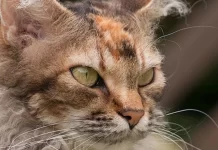Last Updated on September 3, 2023 by Fumipets
Elegance in Motion: The Graceful World of Somali Cats
Somali Cats invites us into the enchanting world of these elegant feline companions. Known for their striking appearance and vibrant personalities, Somali cats are a delightful breed that captures the hearts of cat enthusiasts worldwide.
This summary explores their unique characteristics, history, care requirements, and what makes them cherished members of many households.
Somali Cats
Given the origin of Somali cats, it can be simple to dismiss these stunning cats as “just” long-haired Abyssinians. But there’s a lot more to the tale, as any Somali cat lover will tell you.
The Somali race is amazing. They make the ideal household companion because they are very social.
Somalis are intelligent, sociable, and incredibly energetic cats who love to learn new skills, form relationships with both people and other animals, and thoroughly explore their surroundings. The Somali cat will be a lifetime buddy and partner who will do her best to make sure you never have a boring moment. She is delightfully inquisitive and lively.
Appearance
Red, rosy, tawny, and blue are the four Somali coat hues recognized by the Cat Fanciers’ Association breed standard. Even though they are uncommon and not usually accepted by most breeders or breed organizations, Somalis with other colors, such as tortoiseshell marked or tabby dotted coats, are traded internationally by some breeders.
The Somali’s coat is similar to the Abyssinian cat’s in most other ways, with the exception of having longer hair (although there are short-haired Somalis with coats that are thicker than an Aby’s). Both varieties have the same ticking, which consists of bands of varying colors running from the base to the tip of each hair. Because the majority of Somalis are in the reddish or orange/red color spectrum and have curly tails, they have earned the moniker “fox cats.”
The typical weight of a Somali cat is generally 6 to 10 pounds, and the type is distinguished by its striking face patterns, big oval eyes, and large pointed ears.
Temperament
Get ready for your existence to be monopolized. The Somali is not a cat for those who are weak of heart or those seeking a calm, gentle companion cat. These men like to be in the spotlight and are constantly on the go. At your own risk, try teaching the Somali to retrieve; once they get the hang of it, they won’t want to quit.
Due to their gregarious nature and intelligence, it is crucial to meet a Somali’s fitness requirements in order to maintain her happiness and motivation. Playtime with rules is also a great way to strengthen relationships.
Keeping the animals busy is the most crucial factor. People mistakenly believe that all it takes to connect with a cat is to move a device around while actually doing the sprinting and playing the role of the target. You’re not interacting with them enough if you’re not a little breathless.
Any object that is light enough to be batted around can (and presumably will) be turned into a play by a Somali. It’s okay to use ping-pong pellets, bits of paper, and twist ties. They make great jumpers, adventurers, and snoopers as well. Some of them have even been known to learn how to switch on water taps for a pleasant impact. They are nimble enough to learn how to access cupboards and doorways.
The Somali is a very smart cat that picks up skills easily and enjoys giving performances and being the focus of attention.
Living Needs
The Somali cat is extremely upright. She will therefore ascend to the tallest spot in the space, whether it be a bookcase, the top of a door, or the refrigerator, if you don’t provide her with some ceiling-height cat trees, shelves, cages, and hammocks for her to scale.
They are not animals you want to leave on their own for an extended period of time because of their extremely sociable character, according to Taylor. The Somali is likely to experience separation anxiety if left at home alone without any playmates. She will require access to engaging games, scratching posts, and challenges whenever she is by herself to keep her mind engaged.
These are animals that get along with just about everyone else in the home, whether they have two legs or not. Children of school age are a perfect fit for the Somali’s high degree of vitality and fun. Strangers, other cats (particularly Abyssinians or other Somalis), cat-friendly canines, and even bigger animals like ferrets and mice are always accepted.
Care
Brush repeatedly. That will be the big and little things when it comes to keeping your Somali satisfied. They frequently discard their long, silken hair, which only grows thicker in the summer as they lose some of the weight of their winter covering. According to Taylor, brushing is necessary every day. Additionally, every journey to the litter box has the potential to transform into a “Star Trek” episode as you search for cling-ons because of that long, curly tail.
Health
Somalis are a fairly robust species, much like their Abyssinian relatives. However, they are susceptible to Pyruvate Kinase Deficiency (PKDef), a hereditary condition that can result in anemia. Always deal with a respected breeder who has their cats’ health checked if you want to be positive you’re getting a healthy Somali pup.
Leaving that aside, as your Somali gets older, you and your veterinarian will want to keep a watch out for the full spectrum of common cat health issues like arthritis, heart disease, and renal problems. Periodontal illnesses can also be a problem, so having your Somali’s teeth polished regularly, including by a veterinary every few months, can help keep her cheerful and healthy.

History
According to the CFA, long-haired Abys have been appearing for decades, if not longer, due to a defective trait in the Abyssinian strain. The long-haired pups were for a long time shunned by Aby breeders and swiftly dispatched to be companions rather than display cats.
Many people have different theories about how the long-haired trait first entered the Abyssinian lineage. Similar to this, it is mainly unknown who began raising long-haired Abys. It is undisputed that an American by the name of Evelyn Mague gave the Somali breed its name and took the first steps toward achieving breed status for the cat in cat fancier organizations. This was accomplished in 1979 when the CFA recognized the breed.
Questions & Answers:
What sets Somali cats apart in terms of appearance, and how do they resemble their distant relatives, Abyssinian cats?
Somali cats have a luxurious, semi-long coat with a wild appearance, characterized by ticking or agouti hairs. They share their ancestry with Abyssinian cats, boasting similar body shapes but with longer, flowing fur.
What is the temperament of Somali cats, and how do they typically interact with their owners?
Somali cats are known for their lively, affectionate, and playful nature. They form strong bonds with their human companions and enjoy interactive play and companionship.
Are Somali cats low-maintenance when it comes to grooming their semi-long fur?
While Somali cats have semi-long fur, they are generally considered low-maintenance in terms of grooming. Regular brushing helps prevent matting and keeps their coat in excellent condition.
Are Somali cats good with children and other pets, and do they adapt well to different households?
Somali cats are generally adaptable and can thrive in households with children and other pets. Proper socialization from a young age ensures they get along well with others.
Do Somali cats have any common health concerns, and what steps can owners take to ensure their well-being?
Somali cats are generally healthy, but they can be prone to certain genetic conditions. Regular veterinary check-ups, a balanced diet, exercise, and dental care contribute to their overall well-being.


















